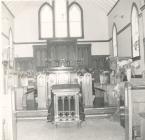15
This picture depicts the interior of Holy Marytrs Anglican Church. Sir William Ford Coakers seat is located at the back of the church.17
The Fisherman's Protective Union members built their leader a home known as "The Bungalow". The home was build under the direction of Bernard J. Miller.The Bungalow was opened as a museum in 1996.
19
While building Port Union, Sir William also built row housing for the workers who were recruited from other parts of the Northeast Coast. This was probably the only row housing of its kind outside the city of St. John's.21
When Sir William looked to the outports for a new location he chose the south west arm of Catalina Harbour. One of his reasons for choosing this site was the river that flowed into the harbour. It was here that he built a power station and formed the Union Electric Company. This Station provided electricity first to Port Union in 1918 and in future years to the rest of the Peninsula.23
The Seal Plant was located next to the ship building facility and it produced seal oil and processed pelts.25
The Fisherman's Union Trading Company by 1919 had 4421 shareholders, more than 40 cash stores and carried an annual trade of fish and supplies of $3,000,000.By 1928 the Fisherman's Trading Company was one of the largest mercantile concerns in the Country with a fleet of 30 Schooners and 3 Steamers most of which were constructed at the Port Union Shipyard.






